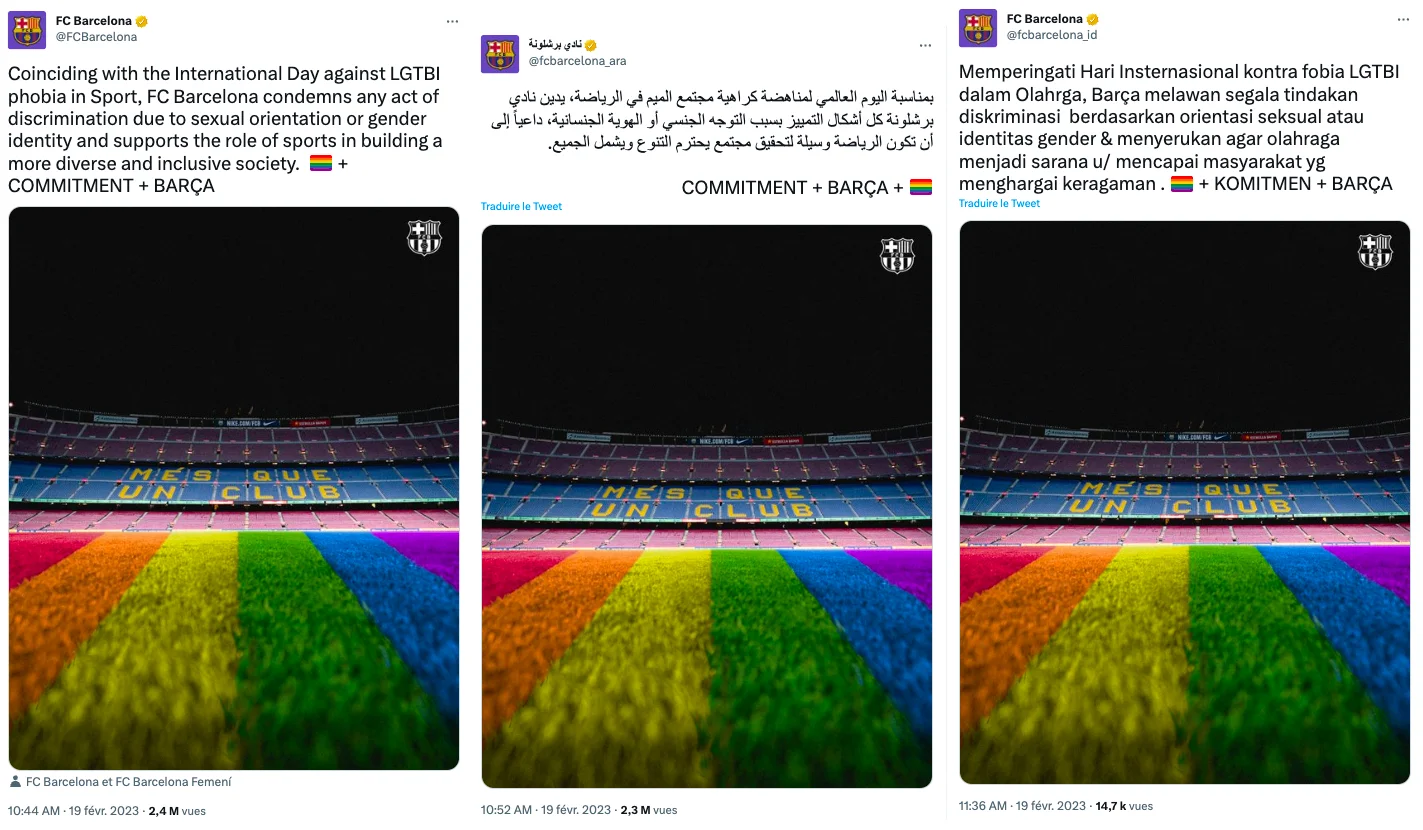Marketing
What is value washing, and why should you avoid it?

Marketing

Maybe you’ve noticed this growing trend in marketing – a giant gas-guzzling car manufacturer that claims to be environmentally conscious or a major cigarette brand that educates on health and well-being topics. When a brand’s words are louder than its actions, we call it value washing.
Yes, sharing your company’s values is a great way to connect with your audience. But choosing to adopt a socially progressive image can also be risky: If there’s no action behind the words, they could be labeled misleading, manipulative, or even fraudulent.
So, how can we avoid this PR disaster? We’re going to review the various types of value washing, explain what differentiates it from true ethical marketing, and what brands can do to stay on the right side of social messaging.
The notion of brands washing their image is not something that appeared spontaneously. It’s the combination of several types of washing, such as greenwashing and purple washing. Value washing refers to manipulating a brand’s image to generate a profit, without fundamentally changing the way the company operates.
However, with the power of the internet, the truth is often quickly discovered and the impact on the company’s image is often worse than before. Let’s look into the many different types of washing out there.
In concrete terms, greenwashing occurs when a brand puts forward ecological messages to improve its image or to make a profit, even though it does little for the planet – something we already discussed in our article on green marketing.
Greenwashing is probably the best-known type of washing, one that has been around since the 1980s. Following the oil crises, gas companies panicked when consumers started turning away from fossil fuels in favor of cheaper alternatives. And because of this, the political discussion on green alternatives started to gain traction.
But instead of making expensive green investments, oil companies realized that they only needed to change the narrative. BP’s logo has since changed from a badge to a green flower, which seems to try to send the message that they are not an oil company. Another example is the term “clean coal”, a fairly new form of greenwashing to distract from the negative reality of the impact on climate change.
While greenwashing is the most well-known form of value washing, it’s not the only one. And of course, the oldest form of discrimination – gender discrimination – is also a common theme for brands.
Who hasn’t spotted companies on LinkedIn promoting gender equality in the workplace when International Women’s Day comes around? Yet some of those same companies fail to implement gender inclusive policies, including a transparent fixed salary scale or programs to enable women to reach higher management positions.
This kind of behavior is known as gender washing or purple washing, and it’s most obvious when looking at a company’s executive team, where women still suffer from the glass ceiling barrier and remain a large minority.
Another of the most dividing social injustices is racism. It also extends to xenophobia, anti-Semitism, and Islamophobia – all forms of rejection of others due to their ethnic, cultural, or religious background.
To try and challenge this situation, some companies try to position themselves as diverse by highlighting people of different origins in their teams. However, if this focus on diversity is just a performative initiative that doesn’t carry through to the rest of the organization, with a lack of representation among employees or DEIB initiatives that support people from diverse backgrounds, then we’re talking about diversity washing.
This kind of value washing technique has been long scrutinized by anti-racist organizations, but also increasingly scorned by the public, following major movements such as Black Lives Matter or Stop Asian Hate. Diversity washing is mainly seen as a way for brands to give themselves an inclusivity badge while making little or no effort, therefore maintaining the status quo.
In the same way that diversity washing affects ethnic minorities, queer washing – also known as pinkwashing or rainbow washing – seeks favor with sexual orientation minorities. You can probably think of a few examples of brands that celebrate but don’t actively support LGBTQIA+ communities, or only highlight them in specific circumstances.
For example, painting crosswalks or staircases in the colors of the rainbow flag while not taking strong measures against violence towards queer people is considered queer washing. Or making Pride month an opportunity for a PR win without real support from LGBTQIA+ rights associations are among the most popular examples of queer washing.
A good example of this backlash for using value washing techniques is FIFA. The soccer organization and its sponsors were embroiled in public backlash during the 2022 World Cup in Qatar, a country with a lack of human rights for women and the LGTBQIA+ community.
Now we’ve defined the most common forms of value washing, let’s find out how good intentions can quickly fall into appropriation.
Let’s be clear – ethical marketing has its good points. By recognizing the existence of certain social causes and highlighting them through marketing actions, companies raise awareness of diversity issues and inequalities. Sexism, racism, and homophobia may be obvious to some, but it’s always better to keep the conversation going. By their very size and power, companies have a responsibility to harness their influence for social good.

This Patagonia campaign features several young people explaining their reasons for participating in the student climate strike.
In addition, competition between companies can also work in favor of ethical marketing. Mailjet, for example, works to promote the reduction of energy consumption in emailing. Our hope is competitors will adopt a similar behavior, proposing initiatives to make emailing greener that will eventually lead to a more ecologically-conscious email industry as a whole.
But it doesn’t stop there. Ethical marketing must also be accompanied by measurable and public actions: Messaging without strong and sustainable progress will send us falling back into value washing.
Let’s be honest, this balancing act is delicate. On the one hand, you must communicate your ethical actions clearly, but on the other, you don’t want to over-promise. Remember, if your claims on ethical commitments are not followed up by actions, you’ll just be making false promises. And regardless of whether it’s intentional or not, deceiving your audience can be really dangerous from a PR perspective.
Companies also need to be careful with how they message their values and commitments. This strategy can quickly raise eyebrows, especially if there’s no tangible proof to support it. It might lead the audience into questioning their motives. What’s more important to a company, the cause or the benefits they expect to reap by supporting said cause?
The good news for brands is that there’s a Code of Conduct to follow to avoid value washing. You have to remember that ethical marketing is first and foremost about the cause and not about the company.
We know it’s easy to get sidetracked, though. That’s why it’s essential to follow some guidelines. We’ll cover a few below but remember – this list is far from exhaustive. Each cause has its own characteristics, so it’s wise to consult with the people directly involved in each cause to learn how to best support them.
As with any marketing activity, the impact of an ethical campaign is first measured with solid, reliable data.
Proof of action could include:
Whatever cause you support, you need to demonstrate tangible evidence that your message is being acted upon.
Lush is really committed to reducing their environmental impacts and proactively share what they’re doing about it with their audience.
Supporting a cause requires starting new alliances while cutting ties with others. For example, if your company is committed to the fight against deforestation, it’s important to stop working with suppliers that are active in the field of deforestation.
Rather than compensate, anticipate and take as much action as possible at the source of the problem you’re fighting. A good example is carbon offsetting: While this is a good start, impactful action includes understanding the root cause and actively participating in the eradication of the problem.
It may seem obvious that if a company supports gender equality or more diversity, it should apply these principles to its own operations. However, that’s not always the case.
Yes, highlighting people with different backgrounds and origins in campaigns can have an impact on public perception and representation. But before you focus on improving your brand image, you’ll need to get your own affairs in order.
Accenture has implemented a series of internal programs and policies to promote women to management positions.
The first place to start is to talk to your human resources department to improve equality and diversity in the company. Take recruitment for example – do interviewers come from a consistent socio-economic background? What about the profiles of the people applying? How are recruiters tackling unconscious bias? Building a DEIB committee that is empowered to look into these processes is the best way to ensure you’re practicing what you preach.
We know, it’s a long process. But it’s also one that will benefit your teams. More diverse teams also mean broader perspectives, which is a great catalyst for progress and innovation and will lead to more successful products and services.
Advocating for social justice is far from a simple task. Supporting some groups of people and causes can clash with the demands of other organizations. It’s a hard truth: Advocacy for some causes will upset others, and you must be prepared for this.
It’s not uncommon for corporate profile images on social media to include a rainbow flag in support of sexual minorities during LGBTQIA+ celebrations. However, in many cases, these cosmetic changes are only made in regions where the rights of LGBTQIA+ people are recognized, while accounts for countries still penalizing homosexuality see no changes.
These actions are a way of leveraging a social cause to project a progressive image of the brand but contribute to maintaining the status quo. Communicating with a public already committed to the cause is like preaching to the choir – there’s less risk and less reward.
Effective ethical marketing takes risks and puts forward a brand’s values to a global audience, even if it means polarizing some of your customer base. For example, soccer club FC Barcelona championed this idea when sharing their commitment against sexuality-related discrimination on all its social accounts on the International Day Against LGBTI-phobia in Sport.

FC Barcelona’s commitment against LGBTI-phobia across all languages of its social accounts.
In everyday life, do you want to be congratulated for your good deeds? If you think that comes off as self-serving or bragging, it’s also the same for businesses.
Of course, you can – and should – communicate your efforts transparently. But don’t forget that the spotlight should always go to the cause, not the company.
Olivier Gantois is the Co-CEO at Tree-Nation, a company that works with brands looking to make a positive impact on the environment and offset their carbon emissions. Tree-Nation knows the importance of its mission and therefore works with companies that are genuinely interested in the cause, rather than using its services as part of a marketing initiative.
We are aware of the practice of greenwashing and have a simple and effective rule: “Don’t spend more on communicating around your tree planting activities than you spend on planting trees.” We encourage companies to be transparent and authentic in their environmental sustainability practices and to invest in concrete reforestation projects rather than spending excessive amounts on advertising.
As you can see, the line between ethical marketing and value washing is thin. Before throwing your company into a cause, set up a diverse focus group and ask your employees what they think about it. This will help you to identify which causes are relevant to your brand. Implementing a social and environmental responsibility policy is a noble first step.
Ethical marketing is not a one-time effort. To have a real impact, it must be done over a long period of time and take the evolution of society into consideration. What was acceptable just a few decades ago may be intolerable today. Conversely, some behaviors that were considered revolting a few years ago are now accepted and encouraged. So, if your brand is willing to dive into ethical marketing, it will be your job to stay up-to-date to ensure your initiatives are relevant and impactful.
Send me the Mailjet Newsletter. I expressly agree to receive the newsletter and know that I can easily unsubscribe at any time.